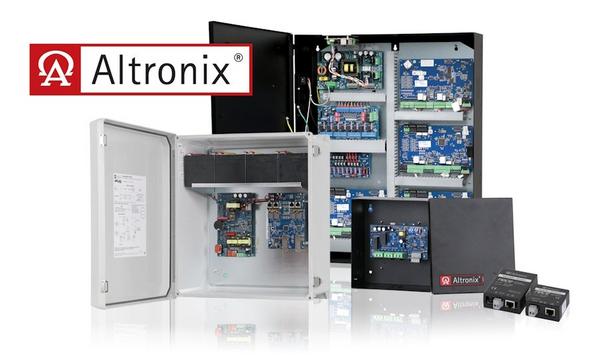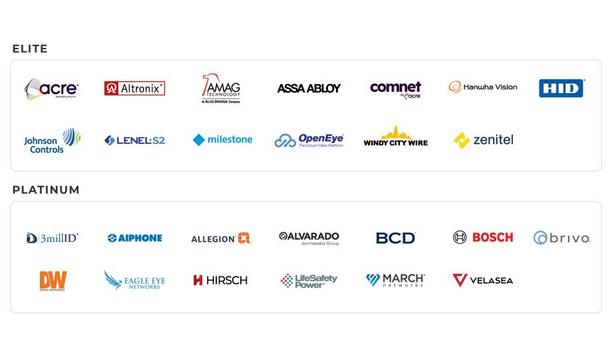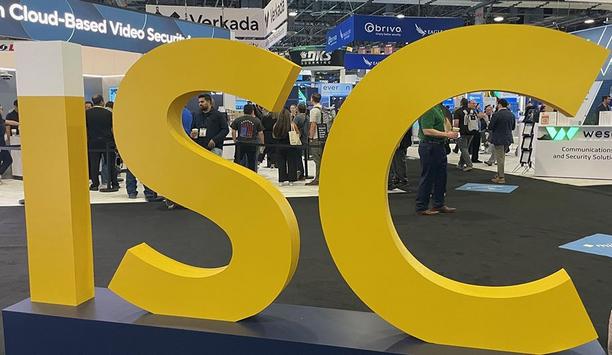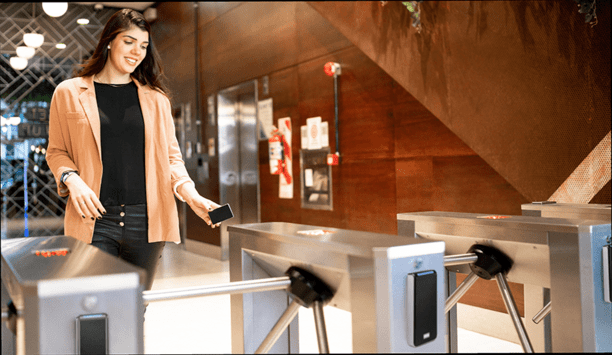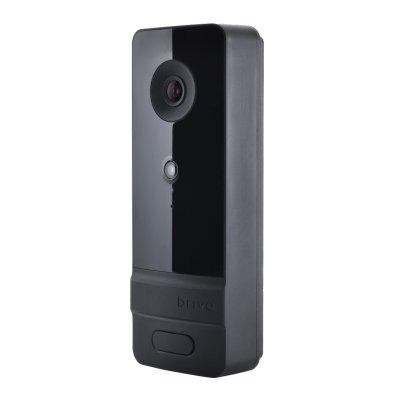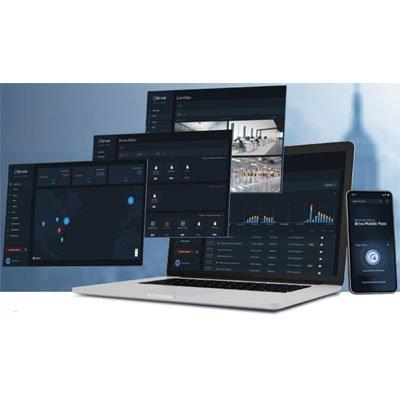Brivo Inc. - Experts & Thought Leaders
White papers from Brivo Inc.
Identity and access management
DownloadSecuring care closer to patients
DownloadAccess management in higher education
DownloadThe welcoming workplace
DownloadAccess and security in the age of hybrid working
DownloadManaging security in the age of boundaryless working
DownloadThe top 4 reasons to upgrade physical security with the Cloud
DownloadAccess control: The enterprise buyer's guide
DownloadEffectively branding a multifamily property
DownloadIntegrating control access and security
DownloadIdentity and access management
DownloadSecuring care closer to patients
DownloadAccess management in higher education
DownloadThe welcoming workplace
DownloadAccess and security in the age of hybrid working
DownloadManaging security in the age of boundaryless working
DownloadThe top 4 reasons to upgrade physical security with the Cloud
DownloadAccess control: The enterprise buyer's guide
DownloadEffectively branding a multifamily property
DownloadIntegrating control access and security
DownloadLatest Brivo Inc. news & announcements
Altronix, a recognised pioneer in power and data transmission for the professional security industry, is showcasing its latest innovations at stand 5/K30 during The Security Event 2025 in Birmingham, UK. The company’s expanding portfolio of products continues to deliver greater versatility and efficiency for systems integrators and end users — streamlining installations, reducing costs, and enhancing system reliability. New technologies and system reliability "The Security Event provides the perfect platform to demonstrate how Altronix manufactures innovative solutions to address today's security challenges," said Ronnie Pennington, Director of Sales for the Americas at Altronix. "We're focused on showcasing new technologies that not only strengthen and protect critical infrastructure, but also deliver measurable ROI through reduced installation costs and enhanced system reliability." Altronix's innovative solutions at stand 5/K30 Visit stand 5/K30 to experience hands-on demonstrations of Altronix's innovative solutions across these technology categories: NetWay Spectrum with EBC48 Integration: Ruggedised outdoor PoE switches delivering up to 90W per port, now with the EBC48 battery charger that recharges 32AH batteries in under eight hours—ideal for remote deployments with intermittent power. New 277VAC input options now available, supporting mission-critical devices over fibre infrastructure. eBridge™ Ethernet over Coax Solutions: Deploy IP devices utilising existing coax infrastructure up to 300m, while saving time and labour without the need to rip and replace the legacy cabling. Pace™ Long-Range Ethernet Solutions: Extend Ethernet connectivity up to 1000 metres over a single pair or 500 metres over structured cabling—enabling IP devices in remote or industrial locations where standard Ethernet falls short. Pace also supports T1L industrial devices like sensors and controllers. Circ™ Redundant Power Solutions: Circ1ATS supports seamless transition between two independent 115VAC or 230VAC inputs, ensuring uptime during power outages and failures to maintain critical security operations. Trove™ Access and Power Integration Solutions: Pre-wired and pre-configured kits support over 50 pioneering access control brands including AMAG, AXIS, Brivo, Mercury, Software House, and TDSi. Solutions are available in scalable wall or rack-mount configurations, simplifying installation and maintenance with a single point of service. Tempo724Q Programmable Timer: This new dual-channel 24/7 network timer is ideal for applications including access control, lighting, automation, and more. Features include dual form “C” relay contacts, advanced LINQ™ technology for remote diagnostics and scheduling, and reliable synchronisation across systems. LINQ™ Network Power Management: Sophisticated remote monitoring platform enabling real-time control and diagnostics for Altronix devices—maximising uptime, enabling preventative maintenance, and optimising overall performance. Altronix representatives will also be available to discuss the company’s Lifetime Warranty and how their USA-manufactured solutions offer long-term value and performance.
The Security Industry Association (SIA) has named new members and leadership of the steering committee for SIA RISE, a community that fosters the careers of young professionals and emerging pioneers in the security industry. Dakota Mackie of Northland Controls serves as chair, with Kelly Ann Christensen of BCD now serving as vice chair. In these roles, Mackie and Christensen ensure that RISE delivers educational content and networking opportunities to young professional employees and rising stars at SIA member companies, college students and recent graduates interested in the global security industry. Prior roles of Mackie Mackie joined Northland Controls in 2020 as the content marketing specialist Dakota Mackie is the business development manager at Northland Controls. Prior to joining the security industry, she worked as a client services coordinator at the Washington Commanders (then the Washington Redskins) before beginning a role with a military nonprofit, Luke’s Wings, where she ultimately ended her tenure as the executive director. Mackie joined Northland Controls in 2020 as the content marketing specialist, and in her current role, she is responsible for supporting the entire sales cycle with a focus on the growth of Northland’s managed services offering. Mackie has been honoured as a SIA Women in Security Forum Power 100 honouree and is a graduate of the University of South Carolina. Outside of work, she has a passion for travelling the world and learning about new cultures. Prior roles of Ann Christensen Kelly Ann Christensen is a digital marketing specialist at BCD, an IP video data infrastructure manufacturer, and has spent nearly five years specialising in the security industry. With a focus on digital advertising and marketing analytics, she has certifications in ROI marketing, marketing management, SEO and PPC marketing. Prior to becoming RISE vice chair, she served as head of the RISE Scholarship subcommittee, which provides scholarships to young professionals in the security industry to assist with furthering education, attending industry events, obtaining new certifications and furthering their professional development, and was awarded the SIA RISE Scholarship in 2022 and one of SIA’s 2024 Sandy Jones Volunteers of the Year. Christensen has also participated in SIA’s Talent Inclusion Mentorship Education (TIME) program, which is designed to promote diversity, equity, inclusion and empowerment of underrepresented identities in the security industry by creating a well-defined pathway for learning and development. SIA RISE Steering Committee The SIA RISE Steering Committee now includes the following members: Chair: Dakota Mackie, business development manager, Northland Controls (Term ends 2025) Vice Chair: Kelly Ann Christensen, marketing manager, BCD (Term ends 2027) AcceleRISE Subcommittee Chair: Erin Grippo, senior manager, product operations, Brivo (Term ends 2025) Content Subcommittee Chair: Tanner LaRocque, marketing director, Evolon (Term ends 2026) Scholarship Subcommittee Chair: Kristin Shockley, manager, segment marketing, Genetec (Term ends 2026) Diversity, Equity & Inclusion Subcommittee Chair: Tristin Vaccaro, owner, Vaccaro Copywriting & Marketing Solutions (Term ends 2025) Jonah Azarcon, deputy project pioneer, M.C. Dean (Term ends 2027) Krystina Beach, marketing communications manager, ASSA ABLOY (Term ends 2027) Andres Capous, regional sales manager, Velasea (Term ends 2027) Joey Joy, distribution channel account manager, March Networks (Term ends 2027) Ryan Knoll, business relations manager, Pro-Tec Design (Term ends 2027) Tim Loth, sales engineer team lead, i-PRO (Term ends 2026) Jackie Paryz, director, sales, technology solutions, Securitas (Term ends 2027) Itzel Portillo, marketing specialist, Allegion (Term ends 2027) Amanda Powell, marketing manager, Boon Edam (Term ends 2025) Nicole Rigby, team lead, distribution operations, Axis Communications (Term ends 2026) Keyser Santana, global security strategist and business execution senior manager, Pratt & Whitney (Term ends 2025) Constantine Tremouliaris, integrated solutions specialist, ASSA ABLOY (Term ends 2025) KeShia Thomas, brand and solutions manager, Allegion (Term ends 2027) Mfon Ubaha, business development manager, i-PRO (Term ends 2027) Sarah Webel, human resources generalist, SAGE Integration (Term ends 2027) Lauren Yonis, global events manager, acre (Term ends 2027) New RISE committee members “SIA RISE is a vibrant community of accomplished young security pioneers and driven industry newcomers that offers a robust array of opportunities for learning, professional development, engagement and relationship building in our industry. This community and its meaningful initiatives would not be possible without our dedicated, talented volunteers, like RISE chair Dakota Mackie, new vice chair Kelly Ann Christensen and our subcommittee chairs, Erin Grippo, Tanner LaRocque, Kristin Shockley and Tristin Vaccaro,” said SIA CEO Don Erickson. “We welcome our new RISE committee members, and we thank outgoing committee members and past RISE chairs Jake Brown and Matt Feenan for their leadership and support over the years. We look forward to working together with the 2025 RISE committee to further advance the reach and impact of RISE and its programs and propel the security workforce of the future.” RISE Awards and annual AcceleRISE conference SIA RISE is a community that fosters the careers of young professionals in the security industry. SIA RISE’s offerings include an annual scholarship to further young talent’s education and career goals, fun in-person and virtual networking events for young professionals, the TIME program for early and mid-career professionals, recognition of new and emerging industry pioneers through the 25 on the RISE Awards and the annual AcceleRISE conference – an essential experience for young security talent. The SIA RISE community is open to all employees at SIA member companies who are young professionals under 40 or have been in the security industry for less than two years.
The PSA Network, the world’s largest consortium of professional systems integrators, announced the 25 members of the PSA Partner Program (P3) for 2025. The P3 program is a performance-driven initiative tailored for technology partners, evaluating and categorising them based on criteria reflecting their impact and achievements within the network. PSA integrators Partners meeting the annual sales threshold are assessed using a weighted scale Partners meeting the annual sales threshold are assessed using a weighted scale. Their cumulative scores determine their placement within two tiers: "Elite" and "Platinum." These partnerships enable PSA integrators to enhance their offerings, deliver exceptional value to end users, and maintain a competitive edge in the market. Unmatched technology solutions "Advancing our mission to elevate the security industry, we are excited to announce our 2025 strategic P3 partnerships with top technology manufacturers,” said Matt Barnette, president and CEO of the PSA Network. “Collaborating with these valued industry pioneers enables us to deliver unmatched technology solutions to our members and their customers." P3 2025 Elite and Platinum partners P3 2025 Elite partners include: acre security, Altronix, AMAG Technology, ASSA ABLOY, etc. P3 2025 Elite partners include: acre security, Altronix, AMAG Technology, ASSA ABLOY, ComNet by acre security, Hanwha Vision, HID, Johnson Controls, LenelS2, Milestone Systems, OpenEye, Windy City Wire and Zenitel. P3 2025 Platinum partners include: 3MillID, Aiphone, Allegion, Alvarado, BCD, Bosch Security and Safety Systems, Brivo, Digital Watchdog, Eagle Eye Networks, Hirsch, LifeSafety Power, March Networks and Velasea. 2025 P3 program features “The P3 partnerships signify PSA’s commitment to staying at the forefront of the security industry, harnessing the latest advancements to provide unmatched solutions,” said Brittany Board, director of technology partners for the PSA Network. The 2025 P3 program features partners offering significant opportunities for the PSA Network. Through P3, PSA expands its offerings for owners and members, including exclusive training and comprehensive certification programs.
Insights & Opinions from thought leaders at Brivo Inc.
ISC West 2025 in Las Vegas showcased the latest advancements in security technology, offering security professionals a glimpse into the future of the industry. This year's expo highlighted the growing influence of artificial intelligence (AI), cloud computing, and enhanced integration. The pioneering comprehensive and converged security event attracted nearly 29,000 industry professionals to the Venetian Convention Centre. Integration into unified platforms Several companies emphasised the importance of cloud-based solutions and the integration of diverse security components into unified platforms. For example, Brivo's Security Suite provides “everything in one platform” – not just access control. Customers only pay for what they use because the system is flexible and scalable from a single door to enterprise level applications. Brivo’s suite includes video, but the system can also tie in with third-party “partners.” Genetec's Security Centre allows for more frequent updates through the cloud. Milestone is undergoing a two-year transition to bring its Xprotect system into the future by incorporating Arcules and Briefcam into a video-as-a service product. Suprema introduced BioStar X, which integrates access control and video analytics into a single platform. AI and mobile credentials Axis Communications’ Cloud Connect product announced three new partnerships at ISC West 2025 Axis Communications’ Cloud Connect product announced three new partnerships at ISC West – Eagle Eye Networks, SecuriThings, and Wesco. They join the three partners announced during the first year of Axis Cloud Connect – Genetec, Kone (elevators) and Milestone. AI and mobile credentials were still hot topics at ISC West 2025, but the conversation has evolved beyond amazement at the technologies’ capabilities and now centres on more practical aspects. From the theoretical to the practical “AI and mobility are still the ‘flavors de jour,’ but messages are evolving to manifest AI for better outcomes,” says Heather Torrey, General Manager, Commercial Security, Americas, for Honeywell Building Automation. The company has reframed its security portfolio to be very building- and business-focused, continuing to grow and evolve after the recent acquisition of LenelS2. “From the theoretical to the practical, we want customers to be part of the conversation so we can deliver AI that is meaningful to them, focusing on what’s most important,” says Torrey. Under Honeywell’s new ownership structure, “each part of the business can be more focused on customers’ needs,” she says. Honeywell continues its journey around mobile access and credentialing and migrating to cloud solutions. Innovations in Access Control Gallagher’s new Quickswitch access control board simplifies the migration from legacy systems Access control remains a critical component of security systems, and ISC West 2025 showcased several innovations in this area. Acre is releasing “Gallery,” its version of the App Store for access control. DormaKaba is launching the Keyscan KC Series door controller with TCP/IP connectivity and enhanced features. Gallagher’s new Quickswitch access control board simplifies the migration from legacy systems. Johnson Controls highlighted its C-Cure command centre and C-Cure IQ web client, offering a unified approach to access control and video. Hardware integrations for security panels For service provider Alarm.com, hardware products prepare a path to greater customer experiences, says Abe Kinney, Alarm.com’s Director, Product Management, who oversees hardware integrations for security panels, sensors, video, etc., and drives new product development. “We are looking to bridge the physical world to digital world,” he says. “We want to bring an advantage to our dealers that they can bring to customers.” Because Alarm.com’s customers pay a monthly fee, the products must be durable and economical, says Kinney. “It should work with no need for truck rolls.” The importance of longevity and flexibility Products are evaluated based on features, price, and ease of installation Products are evaluated based on features, price, and ease of installation. In particular, longevity is important for the Alarm.com’s pro channel. There is also a growing emphasis on deterrence industrywide. Says Kinney: “We recognise that detection is part of it, but we need to prevent problems from happening in the first place. And the industry is re-evaluating.” When it comes to cloud intelligence, Eagle Eye Networks puts the emphasis on flexibility. They offer AI that can perform anywhere on the system infrastructure, on the camera, on their on-site bridge device, or in the cloud. They support their own AI and also any AI product from a third party. “We focus on what customers want from the data AI detects,” says Hans Kahler, Eagle Eye Networks’ Chief Operating Officer. Integration with other systems A timely alert from gun detection could save a life, but AI can also generate information that might be used and analysed later, such as point-of-sale information, dwell time, foot traffic, etc. “What people want is the ability to work with the data for business intelligence,” says Kahler. Integration with other systems provides new opportunities for customers: For example, a licence plate reader at a restaurant drive-thru could trigger customisation of the menu board digital signage based on the customer’s previous buying pattern. Relentless Innovation Assa Abloy handles more than 40 million SKUs for all its various brands, faked in 28 factories in the US Assa Abloy handles more than 40 million stock keeping units (SKUs) for all its various brands manufactured in 28 factories in the United States. Merely complying with regulations such as the “Buy American Act” is a monumental effort considering the massive product line, attendees heard at Assa Abloy’s Annual ISC West Breakfast focusing on compliance challenges in the security market. Meanwhile, back at the trade show booth, Assa Abloy focused on “relentless innovation” in every corner of its product line. Assa Abloy’s message: Innovation in security does not have to be about AI or automation. In fact, inventive approaches to products come in all shapes and sizes and at every level of the product portfolio, and innovation is happening faster than ever. For example, the Safebolt product from Securitech, a brand recently acquired by Assa Abloy, can quickly lock down existing doors with the press of a red button on a cylindrical or mortise lock. Temporary Systems to Secure Events Securing events is the focus of Allied Universal's Unified Command Solutions, which specialises in setting up temporary security systems for conventions, trade shows, festivals, construction sites, parades, and other events. They can add technology to situations where previously mostly security officers were used, providing safety/security and enabling more efficient event operation. “We can put cameras anywhere, whether they need power or not, use cell service or WiFi, a localised network or the internet, or whatever,” says Andrew LaMadrid, VP, Sales for Allied Universal's Unified Command Solutions. Event operation and management IDIS came to ISC West looking to leverage new products that they did not promote in the past The focus is on easy implementation, flexibility, and fast setup and removal. “We look for a solution to solve each customer’s pain points,” says LaMadrid. They specialise in setting up and deploying surveillance cameras for safety/security and for event operation and management. Mobile surveillance is a relatively new “piece of our puzzle” when it comes to protecting high-profile events. “People are excited about what we can offer that’s new,” says LaMadrid. Unified Command Solutions has been around for about 12 years and was acquired by Allied Universal last summer. IDIS came to ISC West looking to leverage new products that they did not promote in the past, and visitors were very interested in those solutions, says Scott Switzer, IDIS CEO. “The progression of our product line has been tremendous,” he says. Last year, the IDIS booth offered only basic analytics, but this year they had 30 different advanced analytics including gun and aggression detection using the advanced solution “IDIS Vaidio AI.” What Makes You Different? The most common question IDIS hears at their trade show booth is: “What makes you different?” The answer: They offer an end-to-end solution, including cameras; they manage, control, design from end-to-end; and there is no need for multiple integrations. The time needed to install an IDIS system is significantly less because of the simplicity. “We have customers we have supported and grown together for over 20 years,” says Switzer. The company previously deployed IDIS cameras under the Costar brand before the Korean IDIS brand was introduced into the U.S. (IDIS purchased Costar and changed the name to IDIS America.) “This has been a tremendous show for us; we are looking to build our momentum and let more people know about IDIS,” says Switzer. Managing real AI at the edge The depth of their metadata enables new applications, whether for security or business operations Based in Prague, Czech Republic, and with U.S. offices in Pennsylvania, FF Group provides licence plate recognition for harsh environments. Using Axis cameras, they offer “managed real AI at the edge,” selling through a nationwide distributed network, says Alex Osypov, CEO and Founder of FF Group. Markets include parking lots, cities/municipalities, police, government, water systems, etc. The depth of their metadata enables new applications, whether for security or business operations. They are looking to combine and correlate data including LIDAR, RADAR, etc. to exploit the advantages of “data fusion.” Osypov says: “The market is growing because we are involving other adjacent markets.” Unified platforms and advanced tools Several companies are focusing on enhancing security operations centres (SOCs) by providing unified platforms and advanced tools. Axon’s Fusus system “layers” onto existing infrastructure, tying together various sensors into a single interface for real-time monitoring and information sharing. Increasingly, enterprises have invested in a lot of technologies – ac, video, asset trackers – but none of it talks together. Fusus ties all the systems together so that operators no longer have to look at 10 different screens. Rather, there is a “single pane of glass” that shows everything and facilitates sharing of information with law enforcement. Motorola also showcased its Security Operations Centre, which integrates hardware, software, smart sensors, communication radios, and broadband devices to streamline incident management.
With the year 2025 stretched out before us, there are many techniques one could use to predict what will happen in the new year. You might analyse historical data and analyse future trends. Or you could try statistical or economic modelling. Or you could develop multiple scenarios based on various assumptions to explore potential outcomes. Or you could just check your email. At this time of year, my email is full of industry folks looking to predict what the future holds in 2025. Ranging from artificial intelligence (AI) to privacy, the retail market to drones, here is a sampling of forecasts for 2025 provided by various players in the security market, courtesy of my email messages. What’s Ahead for AI? From Faisal Pandit, VP & GM, Global Security Products, Johnson Controls (JCI): “The future of security operations includes customisable, scalable solutions where users can control if, when, and how they use AI to improve efficiency depending on the size and function of their organisation.” Says Kevin Woodworth, Vice President, Global Product Management, Intrusion, JCI: “Next year will see a growing focus from product developers on designing systems that streamline setup and configuration through increased AI integration. This reflects a broader trend of leveraging AI to simplify use and enhance adaptability as solutions evolve, rather simply employing it because it’s popular.” From Peter Evans, CEO of Xtract One Technologies: “AI algorithms will significantly advance in distinguishing between harmless, everyday items and potential threats. With this, we will see false alerts become even more rare.” Says JP Castellanos, Director of Threat Intelligence, Binary Defense: “Machine learning (ML)-powered anomaly detection will move beyond proof-of-concept to become mission-critical, enabling teams to uncover unknown threats and behavioural anomalies in real time – well before they escalate.” Evans of Xtract: “As AI becomes more advanced in threat detection, it will lead to more sophisticated protection of individual privacy. We can expect to see more AI techniques utilised for threat identification that do not capture personal data and are privacy-first.” Predictions on interoperability and compliance Woodworth of JCI: “New products added to singular systems must be interoperable. In 2025, organisations will need to embrace interoperability. AI will progress past reactive measures to achieve predictive capabilities.” Pandit of JCI: “With organisations increasing their focus on the regulatory environment, there will be an uptick in specialised certification programs to meet these needs. New security roles will emerge that will be focused on tracking and applying relevant regulatory changes.” Expanding capabilities for video cameras Woodworth of JCI: “Beyond capturing images, cameras will be able to detect potential threats and also mitigate them instantly, issuing vocal warnings, controlling access, or escalating issues without human intervention.” Looking ahead to retail developments Hansel Oh, Director of Product Marketing at Brivo: “Centralized, cloud-based security platforms will enhance credential management and monitor logistical operations to enable retailers to battle cargo theft.” Stephen Burd, Vice President, Essence Security: “With an increase in police response times, sophisticated crime, and smash and grabs, 2025 will see a huge demand for security solutions that go beyond simply notifying the police and will look to actively intervene and prevent damage or loss from occurring.” The role of drones and training Mary-Lou Smulders, CMO, Dedrone by Axon: “Drones will transition from being viewed as supplementary tools to becoming essential components of public safety operations. As departments recognise their effectiveness in various scenarios, the perception of drones will shift, and they will be integrated into core operational frameworks alongside traditional assets like patrol cars while replacing helicopters as a cost-effective and versatile alternative.” Erik Hohengasser, Electrical Technical Lead at NFPA: “As the skilled trades evolve, there will be an increasing demand for specialised and technical training. Predictive analytics, virtual simulations and hands-on experiential learning will become especially valuable due to allowing employees to gain real-world expertise in safe and controlled environments.”
An attention-grabbing exhibit at GSX 2024 in Orlando involved a robot dog that could open a door. Boston Dynamics robot dog ASSA ABLOY impressed attendees with the robotics demonstration, featuring the Boston Dynamics robot dog that could open a door using either an HID credential or a mechanical grip. This innovation represents a shift toward more autonomous security solutions and is suitable for environments where human access may be limited. ASSA ABLOY impressed attendees with the Boston Dynamics robot dog Operational efficiency Eye-catching exhibits at the GSX in Orlando, showcasing the future of security technology It was one of many eye-catching exhibits at the GSX in Orlando, showcasing the future of security technology, and offering practical solutions to the industry's challenges. For security professionals, the advancements presented opportunities to enhance operational efficiency and to maintain a proactive stance in a rapidly evolving market. Control ID face identification Alongside their robot demonstration, ASSA ABLOY also highlighted the Control ID Face Identification. Access Controller, providing advanced facial recognition access control. From identity management to AI-driven surveillance systems, GSX 2024 offered a glimpse into the tools that can streamline processes, increase security, and reduce costs. Here are some other highlights. ASSA ABLOY also highlighted the Control ID Face Identification More integration with critical infrastructure A major theme at GSX 2024 was the increasing integration of security solutions with critical infrastructure. ALCEA (formerly ASSA ABLOY Critical Infrastructure) is an example. Their globalised software solution ALWIN is designed for managing access control, visitor management, and other security factors across multiple locations. ALCEA's approach involves not only internal collaborations within ASSA ABLOY but also partnerships with external organisations. An example of innovation is the Neenah Foundry lockable manhole cover, blending safety and security. Solving identity management challenges The solution simplifies onboarding and access request changes while ensuring compliance with policies Identity management continues to be a key focus in the security sector, and AMAG Technology addresses this need with its Symmetry Connect product. The solution simplifies onboarding and access request changes while ensuring compliance with policies. For professionals overseeing identity access management, Symmetry Connect provides a streamlined, automated approach, reducing human error and increasing operational efficiency. AMAG also sees a growing demand for efficient visitor management systems, especially in the post-COVID landscape. AMAG’s products cater to the need for enhanced security without overburdening staff. AI and cloud-based surveillance solutions Axis Communications highlighted its advancements in AI and cloud-based video management systems with its AXIS Camera Station Edge and Pro products. These solutions can connect seamlessly to cloud systems, providing security professionals with easy access to surveillance data anywhere. With the increasing need for centralised management, Axis’s offerings ensure that security teams can efficiently manage surveillance with minimal infrastructure. Axis also showcased its commitment to AI-driven analytics based on superior video quality. There were also networked audio solutions for public announcements and background music, among other uses. Body-worn cameras for corporate and healthcare uses Traditionally focused on law enforcement, Axon is now expanding its body-worn cameras and TASER technology into corporate, retail and healthcare environments. Their Axon Body Workforce camera is a practical solution for protecting frontline workers in high-risk environments. Axon also introduced drone-based solutions for real-time aerial awareness Axon also introduced drone-based solutions for real-time aerial awareness, a significant benefit for large campuses or remote locations. As more industries adopt corporate surveillance systems, Axon’s offerings provide flexible, scalable solutions that address the need for real-time, actionable intelligence. Cloud-based access for smart buildings Brivo’s native cloud systems and flexible credentials offer practical, future-proof security options Brivo showcased how cloud technology is revolutionising access control by offering systems that integrate seamlessly with other smart building platforms. Their open API approach enables collaboration with IT teams, bridging the gap between physical security and IT management. Brivo’s new partnership with Comcast Smart Solutions illustrates how large enterprises can implement advanced solutions, including access control while maintaining flexibility. For professionals managing complex building environments, Brivo’s native cloud systems and flexible credentials offer practical, future-proof security options. AI-powered multi-sensor camera Hanwha focused on an AI-powered multi-sensor camera, equipped with an NVIDIA processor capable of running complex analytics. In addition, Hanwha’s new AI camera technology can process multiple video streams simultaneously, either stream from its sensors or outside cameras, enabling better tracking of objects in complex environments. Their eight-channel AI Box, which converts legacy cameras into AI-enabled devices, is an attractive solution for professionals seeking to upgrade existing systems without the need for complete overhauls. For security teams looking to enhance situational awareness, Hanwha’s AI-based offerings provide advanced, scalable solutions. Workflow management and hybrid cloud security Genetec continued the theme of integrated solutions with their Operations Centre module for Security Centre, which consolidates work management into a single platform. Built on lean management principles, this system simplifies workflow for security professionals, promoting real-time collaboration across mobile and web platforms. As the industry shifts from on-premises systems to hybrid cloud solutions, Genetec’s products provide seamless transitions for organisations. Their new SaaS Security Centre also allows for natural language video searches in multiple languages, making it easier for global teams to manage operations across locations. Simplifying remote surveillance The company’s focus on scalability and efficiency is demonstrated by the “Eagle Eye Complete” subscription service Eagle Eye Networks showcased their continued international expansion, highlighting a new data centre opening in Saudi Arabia and new hiring initiatives in Australia and Europe. Their “Eagle Eye Anywhere” solar-powered camera system exemplifies the move towards flexible, easy-to-install solutions that can be deployed in remote locations. Integrators benefit from simplified maintenance through remote management, reducing the need for on-site support and ensuring operational continuity. The company’s focus on scalability and efficiency, as demonstrated by the “Eagle Eye Complete” subscription service, reflects the broader industry’s shift toward managed security services. Tailored solutions for commercial clients Everon continues its transition away from its former identity as ADT Commercial. Claiming the status of a competitive commercial integrator, Everon is reinventing itself by offering customised billing and monitoring solutions for a range of industries. Their cloud-based business intelligence platform, which combines video surveillance with data analysis, is aimed at enhancing operational awareness by detecting anomalies such as OSHA violations or retail point-of-sale exceptions. With AI-driven dashboards, clients can customise their security solutions to meet specific needs, reflecting a growing demand for tailored, data-driven security applications. Innovation through cloud and mobile LenelS2 is part of Honeywell, and they emphasised their investment in cloud and mobile solutions at GSX 2024. Their "Enterprise OnGuard Cloud" platform, launched in June 2024, is a testament to the growing demand for cloud-enabled access control systems. With the addition of NFC-enabled Blue Diamond credentials, LenelS2 is pushing towards smarter, more secure mobile access options. The strategic combination of Lenel’s solutions with Honeywell’s infrastructure offers users enhanced engineering capabilities and global reach. This reflects a broader market trend of integrating mobile devices into physical security protocols. Bringing AI to everyday security LPR system, combined with their Searchlight Cloud Analytics, offers a powerful tool for identifying security risks March Networks highlighted their new AI-driven smart search feature, designed to help security teams quickly detect operational anomalies in retail and financial environments. From identifying misplaced cash in quick-service restaurants (QSRs) to detecting "jackpotting" attacks on ATMs, their solution highlights the increasing importance of AI in enhancing both security and operational efficiency. Their Licence Plate Recognition (LPR) system, combined with their Searchlight Cloud Analytics, offers a powerful tool for identifying and responding to security risks in real-time, emphasising the practicality of AI in daily security operations. Driving sustainability in security Securitas showcased its commitment to sustainability, a growing concern for businesses across all industries. By providing CO2 data for clients and promoting digital tools like mobile credentials, Securitas is leading the charge in creating greener, more sustainable security solutions. Their focus on remote services and occupancy insights offers companies a way to reduce their environmental impact while enhancing security operations. The company’s alignment with science-based targets and circular economy practices signifies the increasing role sustainability will play in the security sector. Future lies in integration The GSX 2024 trade show revealed that the future of security lies in intelligent integration, AI-driven analytics, and cloud-based management systems. The innovations presented will help security professionals streamline their operations, enhance situational awareness, and future-proof their systems. As these technologies continue to evolve, professionals must stay informed about the latest advancements to maintain a competitive edge in the security marketplace. GSX was a great place to start. At the end of the day at GSX, it wasn’t just the robot dog that was opening doors …. to the future of security systems. {##Poll1727925373 - Of the important factors highlighted at GSX 2024, which do you consider most when adopting new security solutions?##}
Using artificial intelligence (AI) to automate physical security systems
DownloadA modern guide to data loss prevention
Download7 proven solutions for law enforcement key control and asset management
DownloadThe truth behind 9 mobile access myths
DownloadAccess control system planning phase 2
Download





























